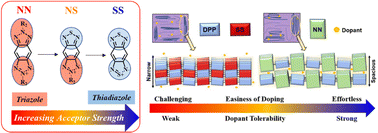Structural influences of proquinoidal acceptor moieties on transistor performance and doping capability for diketopyrrolopyrrole-based dual-acceptor conjugated polymers†
Abstract
In this study, we design and synthesize three DPP-based dual-acceptor conjugated polymers comprising different proquinoidal heterocyclic acceptors, including benzobisthiadizole (SS), triazolobenzothiadiazole (NS), and benzobistriazole (NN), and investigate their structure–property relationship using a transistor and their conductive states by doping. Owing to the high-spin and proquinoidal characteristics of the NN/NS/SS units, all the prepared polymers possess free radicals. However, a subtle difference in the proquinoidal characteristics among these acceptor units results in varied backbone rigidity and coplanarity of the derived polymers. DPP-NS and DPP-NN are shown to possess better solid-state stacking and crystallinity than DPP-SS, conferred by the alkyl side chains on the triazole unit. Hence, DPP-NS and DPP-NN can deliver enhanced mobilities of 3.0 × 10−2 and 5.3 × 10−2 cm2 V−1 s−1, respectively, after appropriate thermal annealing whereas the stiff DPP-SS only shows a minor improvement. Furthermore, the intrinsic intense radical characteristic of the NN unit is shown to facilitate the receivability of dopants. At a low doping concentration, DPP-NN delivers the highest conductivity of 23.8 S cm−1 among these polymers. Besides, owing to the higher degree of flexibility in chain packing and associated chain aggregation, DPP-NN displays a superior capability to resist the structural deconstruction in the doping state at a high concentration compared to DPP-NS and DPP-SS. Concisely, our results unravel the non-trivial influence of a proquinoidal acceptor moiety on transistor performance and doping capability of the derived polymers.

- This article is part of the themed collection: Journal of Materials Chemistry C HOT Papers


 Please wait while we load your content...
Please wait while we load your content...